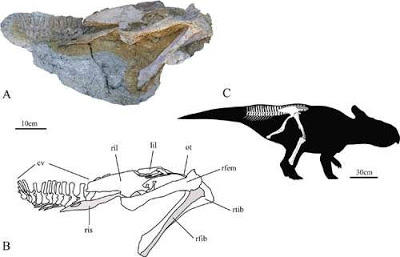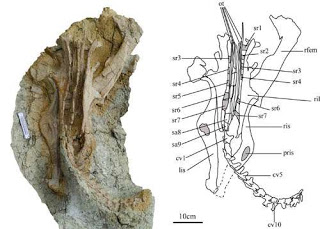
The leptoceratopsids are a group of small, quadrupedal horned dinosaurs that have so far been found exclusively in the Upper Cretaceous of Asia and western North America. With a typical body length of about two meters, they are much smaller than the contemporary ceratopsids.
HE Yiming, a Ph. D. student of Institute of Vertebrate Palaeontology and Paleoanthropology, Chinese Academy of Sciences, and his collaborators reported a new leptoceratopsid dinosaur, Ischioceratops zhuchengensis, from the bone-beds of the Upper Cretaceous Wangshi Group of Zhucheng, Shandong Province, China. This fossil represents the second leptoceratopsid dinosaur specimen recovered from the Kugou locality, a highly productive site in Zhucheng. This finding published on December 23 in PLoS ONE 10(12) increases the known taxonomic diversity and morphological disparity of the Leptoceratopsidae and has significant implications for interpretations of neoceratopsian biogeography.
The new species is based on an incomplete, partially articulated specimen including the entire sacrum, a few ossified tendons, both halves of the pelvis, the anterior-most 15 caudal vertebrae in an articulated series, and the right femur, tibia and fibula.
Leptoceratopsids are characterized by robust jaws equipped with highly specialized large teeth and, unlike ceratopsids, lack horns and have extremely short frills. They share some of the advanced features seen in ceratopsids and are closely related to the latter group. Three taxa have been described from the Upper Cretaceous of Asia: Asiaceratops salsopaludalis from Uzbekistan, Udanoceratops tschizhovi from Udan-Sayr, Mongolia, and Zhuchengceratops inexpectus from the Kugou locality, Zhucheng, China.

The ischium of Ischioceratops zhuchengensis is morphologically unique among known Dinosauria, flaring gradually to form an obturator process in its middle portion and resembling the shaft of a recurve bow. An elliptical fenestra perforates the obturator process, and the distal end of the shaft forms an axehead-shaped expansion.
The new specimen, like Zhuchengceratops, comes from the Kugou locality. This locality, together with Longgujian (just 600 m north of Kugou) and Zangjiazhuang (5 km away from Kugou), has yielded numerous hadrosaurid bones. The Zangjiazhuang locality has also produced several tyrannosaurid elements and some material atrributable to Sinoceratops zhuchengensis, the only undisputed ceratopsid from outside of North America. “Though lacking cranial elements, the newly collected specimen possesses some morphological features that identify it as a new leptoceratopsid”, said He Yiming, lead author of the study.
“The holotype of Ischioceratops was found at approximately the same stratigraphic level within the Kugou quarry as the holotype specimen of Zhuchengceratops, but there are no overlapping skeletal elements between the two specimens. Our phylogenetic analysis shows that Zhuchengceratops has a close relationship with Ischioceratops in Leptoceratopsidae. Therefore, we provisionally consider Ischioceratops and Zhuchengceratops to be distinct taxa”, said XU Xing, study coauthor and project leader, Institute of Vertebrate Palaeontology and Paleoanthropology in Beijing.
Reference:
Yiming He et al. A New Leptoceratopsid (Ornithischia, Ceratopsia) with a Unique Ischium from the Upper Cretaceous of Shandong Province, China, PLOS ONE (2015). DOI: 10.1371/journal.pone.0144148
Note: The above post is reprinted from materials provided by Chinese Academy of Sciences.










